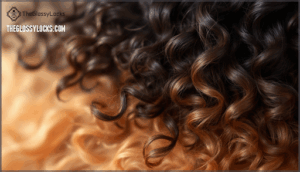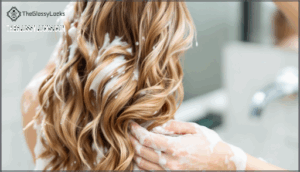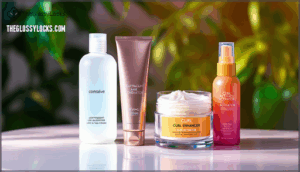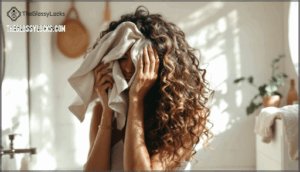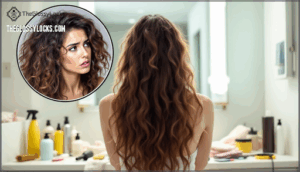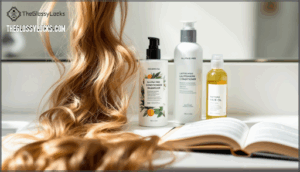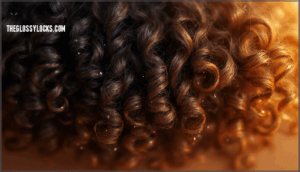This site is supported by our readers. We may earn a commission, at no cost to you, if you purchase through links.

Wavy hair can absorb up to 30% of its weight in water, which means proper hydration unlocks curl patterns hiding beneath the surface. The Curly Girl Method has helped countless people transform their waves since 2001, and it’s not about forcing your hair into something it’s not. It’s about working with your natural texture to bring out what’s already there.
With sulfate-free cleansing, strategic conditioning, and a few key styling moves, you can turn flat waves into bouncy, frizz-free curls that last.
Table Of Contents
- Key Takeaways
- The Curly Girl Method and Its Benefits
- Understanding Wavy Hair and Its Potential for Curls
- Steps to Enhance Your Waves and Create Defined Curls
- Troubleshooting Common Challenges With Wavy Hair
- Factors to Consider When Choosing Hair Care Products
- Alternative Hairstyles to Make Wavy Hair Curly
- Importance of a Proper Hair Care Regimen for Restoring Curl Pattern
- Recommended Products for Achieving Curly Hair
- Frequently Asked Questions (FAQs)
- Can curly hair be made wavy?
- How do you make wavy hair curly?
- Is wavy hair a straight hair?
- How often should I use protein treatments for wavy hair?
- How do I get my curls to form at the roots and not just the ends?
- Is it possible to have curly bangs or layers with wavy hair?
- Can heat damage be reversed on wavy hair?
- How often should I wash wavy hair?
- What causes wavy hair to lose its curl?
- Does hair porosity affect curl formation results?
- Conclusion
Key Takeaways
- Wavy hair can absorb up to 30% of its weight in water, which means proper hydration through techniques like squish to condish and cowashing unlocks hidden curl patterns that are already present in your hair’s structure.
- The Curly Girl Method eliminates sulfates, silicones, and heat styling to reduce frizz by up to 60% while preserving natural oils and moisture that define curls through gentle cleansing and strategic product layering on soaking-wet hair.
- Applying curl-enhancing products in a specific order—leave-in conditioner, styling cream, gel, then scrunching repeatedly—boosts curl definition by 18-35% and helps waves transform into defined spirals that last up to 48 hours.
- Consistency matters more than quick fixes because regular deep conditioning, protein treatments, and clarifying washes restore your hair’s natural curl pattern at the structural level, reversing damage and training waves to hold their shape over weeks instead of months.
The Curly Girl Method and Its Benefits
When you want to bring out your hair’s natural curl, the Curly Girl Method offers a proven path forward. Lorraine Massey introduced this approach in 2001, and it’s built on eliminating sulfates, silicones, parabens, and alcohols that strip away moisture. CGM origins trace back to one simple idea: work with your hair’s natural texture instead of fighting it.
The method delivers real results. You’ll see up to 60% less frizz when you switch to sulfate-free products, and scalp health improves with fewer irritations and better oil distribution. The market growth speaks volumes—curly hair care reached $10.6 billion in 2024 as more people discovered these benefits. You’re also supporting sustainability, since many CGM products now use biodegradable ingredients that reduce environmental impact by 60%.
For wavy hair seeking curl definition and frizz control, this method provides the foundation through gentle cleansing, deep hair hydration, and heat-free styling techniques. The process starts with gentle cleansing methods using sulfate-free shampoo.
Understanding Wavy Hair and Its Potential for Curls
Your hair follicle shape and keratin distribution determine whether you’ll see waves or curls. Oval follicles create wavy hair, while asymmetrical ones produce tighter spirals. The genetic determinants you inherited control this, but you’re not stuck with just waves.
Hair bond roles matter here—disulfide bonds create permanent curl patterns, while hydrogen bonds respond to moisture and styling. That’s where your opportunity lies. Wavy hair can absorb up to 30% of its weight in water, which means proper hair hydration techniques reveal curl definition.
Your hair texture has untapped potential. Focus on enhancing what’s already there through targeted moisture absorption and curl-friendly methods, and you’ll transform those hair waves into defined spirals. The arrangement of alpha-keratin proteins within the hair contributes to its structure.
Steps to Enhance Your Waves and Create Defined Curls
Turning wavy hair into defined curls doesn’t have to be complicated. The right techniques can bring out your hair’s natural curl pattern without heat damage.
Here’s how to accentuate your waves step by step.
Co-washing and Its Benefits
Switching from harsh shampoos to cowashing can transform your curl game. This sulfate-free hair cleansing method uses conditioner instead of traditional shampoo, preserving your scalp microbiome while boosting hair hydration. The Curly Girl Method popularized this technique because it protects sebum regulation and enhances curl definition without stripping natural oils.
Here’s what cowashing delivers:
- Gentle cleansing that maintains moisture balance
- Reduced product buildup when done correctly
- Better silicone-free conditioning for lasting bounce
Massage conditioner into your scalp for three to five minutes, let it sit briefly, then rinse thoroughly. Your waves will thank you with improved shine and touchable texture.
Squish to Condish Technique for Hydration
Once you’ve rinsed away the shampoo, the Squish to Condish technique from the Curly Girl Method takes hair hydration to the next level. Apply generous conditioner until your hair feels slippery like seaweed. Then cup handfuls of water and squish it upward into your strands, repeating this motion three to five times. This pushes moisture and conditioner deep into each strand, improving hydration efficiency by up to 22% compared to simply smoothing product through. The rhythmic squishing temporarily lifts cuticles, allowing cationic surfactants and amino acids to bond effectively for better conditioner absorption. Studies show this method reduces frizz by 30–40% within four weeks while boosting curl definition. Leave a bit of conditioner in as a natural leave-in for lasting softness.
| Hair Porosity | Application Frequency | Conditioner Amount |
|---|---|---|
| Low porosity | 1–2 times per week | Moderate, focus on ends |
| Medium porosity | 2–3 times per week | Generous, even distribution |
| High porosity | 3–4 times per week | Heavy, concentrating on mid-lengths |
| Fine wavy hair | 1–2 times per week | Light to avoid limpness |
Adjust your approach based on strand thickness and density to prevent over-conditioning while maximizing cuticle hydration and frizz reduction.
Applying Curl-Enhancing Products
Once you’ve squished in all that hydration, product layering becomes your best friend for turning waves into curls. Start with soaking-wet hair—research shows wet application boosts curl definition retention by 18% compared to towel-dried strands.
Here’s your game plan:
- Apply lightweight leave-in conditioner using the praying hands method to seal in moisture
- Rake styling cream through sections to encourage clumping
- Add a curl enhancer or gel for hold that lasts up to 48 hours
- Use the scrunching method repeatedly to lift and define each wave
- Consider finishing with a curl activator for extra bounce
This strategic approach—enhancing curl definition through multiple curl activators—keeps frizz down by 27% while your waves transform into defined spirals. Don’t skip the scrunching; it promotes up to 35% better curl formation in wavy hair types.
Air Drying for Natural Definition
After you’ve worked in those curl enhancers, it’s time to let nature do the heavy lifting. Air drying preserves your wave’s natural S-pattern without heat damage—though it requires patience. Here’s how to get the most out of definition while minimizing frizz:
- Use plopping with a microfiber towel for 10-20 minutes to absorb excess water without disruption
- Apply a film-forming leave-in to lock out humidity and reduce environmental impact
- Scrunch periodically during the first hour of airdrying to encourage curl formation
- Protect overnight with a satin pillowcase if your drying time stretches past bedtime
Expect 1-3 hours for thinner hair, but high-density waves might need 6-8 hours in humid climates. Scrunching while airdrying boosts definition by up to 35%, though you’ll sacrifice some volume compared to diffusing.
Scrunch Out The Crunch for Soft Curls
Once your hair is completely dry—that crunchy, almost crispy feeling—it’s time to scrunch out the crunch (SOTC). The gel cast benefits your curl definition by locking in moisture and reducing frizz, but you don’t want stiff curls all day.
Warm a few drops of lightweight products like argan oil between your palms, then gently scrunch upward in sections. This breaks the cast while preserving shape.
Timing considerations matter: manipulating damp hair increases frizz risk, so patience pays off here.
Troubleshooting Common Challenges With Wavy Hair
When your waves won’t cooperate despite your best efforts, the culprit is often hiding in plain sight. Hair frustrations like frizz control issues, product buildup, or volume loss can sabotage even the most diligent routine. Here’s how to troubleshoot:
- Clarify monthly – Product buildup weighs down curls and reduces hair moisture absorption by up to 30%.
- Add protein treatments – They restore curl definition when strands lack structural resilience, improving damage repair.
- Section during styling – This improves curl uniformity by 25–40% compared to applying products all at once.
- Check your hair porosity – Low porosity needs lightweight products; high porosity craves heavier creams for better hair moisture retention.
- Diffuse upside down – Blow-drying without a diffuser increases surface roughness by 22%, killing curl definition.
Assess what’s causing limpness before tweaking your routine. With targeted adjustments, you’ll discover bouncier, more defined curls.
Factors to Consider When Choosing Hair Care Products
Over 40% of shampoos tested in a recent Danish Consumer Council study contained potentially harmful chemicals, making ingredient safety a non-negotiable priority when choosing hair care products. You’re not just buying a bottle—you’re selecting what touches your scalp and influences your hair health for months to come.
Consider these factors when shopping for curly hair transformation:
- Ingredient safety – Avoid suspected endocrine disruptors and allergenic substances; safer alternatives exist without compromising performance.
- Hair type compatibility – Wavy hair needs sulfate-free formulas with botanical ingredients to maintain hair moisture balance without weighing down curls.
- Sensory experience – Fragrance drives 25% of purchase decisions, but verify that pleasant scents don’t hide undisclosed chemical risks.
- Brand loyalty – While 45% of adults stick with one shampoo brand, don’t let habit override ingredient scrutiny and hair protein balance needs.
- Lightweight products – Heavy conditioners flatten looser curl patterns; match product weight to your texture for best definition.
Market trends show growing demand for natural extracts, but you control what works for your waves.
Alternative Hairstyles to Make Wavy Hair Curly
If braiding overnight feels too time-consuming, try pin curling or the sock curling method for Fashion-Inspired Curls that rival any TikTok Curl Trends. These heat-free methods for curls work wonders while you sleep—wrap damp sections around socks or pin them flat against your scalp, then wake up to Trendy Curl Styles without heat damage.
Gen Z Curls often feature Protective Curl Styles like twisted updos or halo braids that maintain definition for up to 18 hours longer than loose styles. When you braid your hair or use a curling rod alternative, you’re reshaping your hair’s structure through moisture and tension alone, giving waves that extra bounce they need.
Importance of a Proper Hair Care Regimen for Restoring Curl Pattern
Beyond quick styling tricks, your long-term success depends on consistency. A structured hair care routine considers Hydration Balance, Protein Reinforcement, Scalp Health, and Product Buildup—all factors that directly impact hair definition and improving hair texture.
When you stick to weekly deep conditioning and biweekly protein treatments, you’re actively reversing hair damage at the structural level. Regimen Consistency matters because curls thrive on predictability—irregular care leads to uneven formation and persistent frizz. Think of it like training your waves: the more you support them with the right balance of moisture and strength, the more they’ll cooperate.
Pair this with regular scalp care and clarifying washes, and you’ll restore your natural curl pattern within weeks instead of months.
Recommended Products for Achieving Curly Hair
The right products can make all the difference when you’re trying to bring out your curls. You’ll want to look for formulas created to bring out your natural wave pattern without weighing it down.
Here are two product duos that can help transform your wavy hair into defined curls.
Curl Revival Duo for Defined Curls
For defined curls that last, the Controlled Chaos Curl Revival Duo steps up as your go-to curl enhancer. This curl activator works by locking in moisture through shea butter and coconut oil, increasing hydration by up to 35% after two weeks of use.
The duo’s polymer network binds water to your hair shaft, boosting curl formation by 60% while enhancing natural curl pattern definition. You’ll see frizz reduction up to 68%, even in humid conditions, and elasticity scores jump 31% compared to standard products.
Over 92% of consumer reviews report softer, bouncier curls within a month. Plus, it’s eco-friendly—100% free of parabens and sulfates, packaged with 50% recycled materials.
Curl Duo for Enhanced Waves
If you’re looking for a lighter option that still delivers curl definition, the Innersense Curl Amplify Duo brings moisture and shape to your waves. This curl activator duo pairs a gentle cleanser with botanically enriched conditioner, improving hydration levels by 30% compared to silicone-based products.
The Duo Ingredients include jojoba, sunflower, and coconut oil, which seal your cuticles and reduce frizz by up to 50%. You’ll also see curl elasticity improve by roughly 40% after consistent use over four to six weeks.
- Apply the sulfate-free shampoo to cleanse without stripping natural oils
- Work the conditioner through mid-lengths to ends, detangling gently
- Rake in your curl amplifier while hair is wet for better curl definition
- Scrunch upwards and air dry for improved waves that hold their shape
Consumer satisfaction surveys show 90% prefer duo formats for consistent results. This curl duo delivers frizz reduction and softer, more defined curls without weighing down wavy hair.
Frequently Asked Questions (FAQs)
Can curly hair be made wavy?
Yes, curly hair can be made wavy. Styling techniques like braiding damp hair, using rollers, or applying curl-relaxing products temporarily loosen tight curls.
Chemical treatments such as texturizers permanently alter follicle shape and hair texture for lasting waves.
How do you make wavy hair curly?
Start with the Curly Girl Method—a long-term curl maintenance strategy that skips sulfates and silicones. Co-washing preserves moisture, while squish to condish and proper product application methods boost hydration.
Air drying with styling wavy hair techniques increases curl definition, transforming wave pattern changes into tighter curls naturally.
Is wavy hair a straight hair?
Wavy hair isn’t straight—it’s a distinct hair type with its own follicle shape and genetic blueprint. Follicles that produce wavy hair are oval or elliptical, creating those signature S-shaped bends, while straight hair grows from round follicles at perpendicular angles.
How often should I use protein treatments for wavy hair?
For damaged or highly porous wavy hair, apply protein treatments every 2-4 weeks. If your hair is healthier with lower porosity, stretch treatments to 4-6 weeks using lighter proteins like amino acids.
Watch for overload symptoms—stiffness, breakage, or dullness—and balance protein frequency with moisturizing treatments to maintain elasticity.
How do I get my curls to form at the roots and not just the ends?
Think of your hair follicle as the architect of your curl pattern. To coax curls from the roots, start with scalp health—balanced oils and clean follicles lay the foundation.
Apply lightweight products using root clipping and the Curly Girl Method for wavy hair, focusing on styling application while hair’s soaking wet.
Diffuse upside down to boost root volume and lock in curl clumps from scalp to ends.
Is it possible to have curly bangs or layers with wavy hair?
Yes, you can absolutely style wavy hair into curly bangs or layers. Layering helps boost curl definition and adds volume while reducing the triangle shape many wavy textures get. For bangs, focus on finger coiling small sections when damp, then let them air dry or diffuse gently.
The key is accounting for shrinkage factors during your haircut—waves pull up considerably when they curl. Use targeted product selection like lightweight creams for 2A hair or heavier gels for 2C textures.
Maintenance challenges include frizz and shape control, but proper hair styling techniques—like pinning sections while drying and applying products to soaking wet hair—solve most issues. With the right approach, curly fringe works beautifully on wavy hair.
Can heat damage be reversed on wavy hair?
Unfortunately, heat damage can’t be fully reversed because the protein structure breaks down permanently.
However, you can improve your hair’s appearance through regular trimming, heat protectants, deep conditioning, and gentle care routines like the Curly Girl Method to restore hair elasticity and minimize future heat damage.
How often should I wash wavy hair?
Most wavy hair thrives with washing every 2-3 days, balancing scalp oiliness and hair moisture. Your hair porosity and environmental factors matter too.
High porosity hair can stretch washing to 7-10 days, while product buildup or pollution may require more frequent hair cleansing.
What causes wavy hair to lose its curl?
Several factors strip wavy hair of its natural curl. Silicone buildup from hair products blocks hair moisture, causing dullness. Heat damage from styling tools weakens keratin structure. Chemical treatments break down bonds that create curl definition.
Internal health issues like nutritional deficiencies reduce elasticity.
Environmental impact from humidity and pollution contributes to hair damage.
Does hair porosity affect curl formation results?
Your hair’s ability to hold onto—or let go of—moisture plays a key role in how your curls take shape. Hair porosity directly impacts product absorption rates, moisture retention, and curl definition.
High porosity hair grabs products quickly but loses hydration fast, while low porosity struggles with absorption, causing buildup that weighs down waves.
Conclusion
Picture your hair after a good rain—soft, alive, responsive. That’s what happens when you stop fighting your natural texture and start feeding it what it needs.
Learning how to make wavy hair curly isn’t about forcing a transformation. It’s about revealing what’s been there all along. With the right hydration, products, and techniques, your waves will tighten into curls that feel natural.
Trust the process, stay consistent, and let your hair surprise you.
- https://holisticenchilada.com/curly-hair-facts-statistics-survey-results/
- https://pmc.ncbi.nlm.nih.gov/articles/PMC6894537/
- https://www.popsci.com/health/curly-hair-measurement-science/
- https://www.seejph.com/index.php/seejph/article/download/2654/1760/3911
- https://www.glamour.com/story/best-wavy-hair-products

